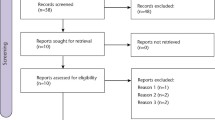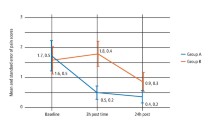Abstract
Objective An audit study which examines patient's opinions on the efficiency of two analgesic regimes prescribed to them following dento-alveolar surgery in our Day Unit.
Design Single centre prospective study.
Setting Oral Surgery Day Case Unit
Subjects One-hundred-and-seventy-four adults undergoing routine dento-alveolar surgery under general anaesthetic were asked to assess their pain control (on a five point scale) 1 hour after surgery, at discharge from hospital and at 24 and 48 hours post-operatively. Post-operatively, patients received ibuprofen 400 mg three times daily for five days or two tablets of paracetamol 500 mg with codeine 30 mg six hourly for 5 days if they were allergic to aspirin or were asthmatics sensitive to aspirin. Patients were not given local anaesthesia intra or post-operatively.
Results Completed records were obtained for 161 (93%) patients. Ibuprofen was apparently adequate in controlling pain for 147 out of 161 patients but on further questioning 42 of these patients took supplemental analgesics and self-prescribed paracetamol or a paracetamol combination. Thirteen patients who were prescribed paracetamol with codeine had adequate pain control and did not take supplemental analgesics. One patient did not require any analgesics post-operatively
Conclusion Telephone contact with patients 24 and 48 hours post-surgery provides a valuable assessment of pain control following discharge from a day surgery unit. Ibuprofen offered satisfactory control of pain for 65% (95) of patients who underwent routine dento-alveolar surgery. Discharge prescriptions must be given with verbal and written instructions to ensure that patients take the correct dose and self-prescription is within safe doses.
Similar content being viewed by others
Main
Routine dento-alveolar surgery is commonly undertaken on a day case basis. Pain, trismus and swelling are the most common complaints post-operatively.1 A recent national survey of post-operative analgesia in day surgery units in England and Wales highlighted that 70% of respondents feel that pain is a problem following day surgery and 90.8% of units supply their patients with analgesic drugs to take home.2 In a review of analgesics3 commonly used to control pain after third molar surgery, the non-steroidal anti-inflammatory drug, ibuprofen 400 mg three times a day (tds) for 5 days4,5 was noted to be an effective analgesic regime. A single dose of ibuprofen 400 mg has been reported to provide significant pain relief in the early post-operative period after third molar surgery.6,7,8,9 Paracetamol 500 mg combined with a centrally acting analgesic such as codeine phosphate 30 mg was also noted to be effective in pain control.10,11 This regime is used for patients who are allergic to aspirin or are unable to take aspirin because of medical problems (ie 'sensitive' asthmatics, diabetics, patients on anticoagulant therapy etc). The above two regimes are given in our Day Case Unit at Manchester Royal Infirmary and this article reports on the effectiveness of our prescribed regimes by evaluating patient's satisfaction with pain relief.
Method
One-hundred-and-seventy-four patients undergoing routine oral surgical procedures under general anaesthesia as day cases over a 3-month period were questioned about their pain control up to 1 hour after surgery, at discharge, by telephone at 24 and at 48 hours. The patients' age, sex, pre-operative pain, type of surgery performed, length of operation and time at which surgery ended were recorded. Pain at 1 hour post-operatively and at discharge from hospital were also noted (Fig. 1).
Patients graded their response to pain at 24 and 48 hours according to the scale:
-
1
No pain
-
2
Mild pain but tolerable
-
3
Moderate pain but tolerated
-
4
Moderate pain not controlled by prescribed pain killers
-
5
Severe pain not controlled by additional pain killers
Patients were also asked if they had taken other non-prescribed analgesics during the 48 hour post-operative recovery period. All procedures were performed by the surgeons and anaesthetists who regularly operated on day surgery lists. Peri-operative analgesia was provided by a single bolus dose of fentanyl 1μg/kg.
The policy of our day unit is to prescribe ibuprofen 400 mg three times daily for all patients except those groups with allergy to aspirin or are 'sensitive' asthmatics when paracetamol 500 mg with codeine phosphate 30 mg two tablets six hourly were prescribed. If the prescribed analgesics were not effective, Tramadol 100 mg was available as rescue medication for patients prior to discharge from the Day Unit. Most of the staff prescribing the above regimes were not aware of this study and no attempt was made to alter surgical technique or prescribing regimes for post-operative analgesia.
The pain scores were dichotomised and chi-squared tests were used to compare the differences for patients in each analgesic group. No significant differences were found, however as the numbers of patients falling into the groups were small, the power of detecting clinically important differences in pain score was low. As this finding had no great bearing on the conclusions of this audit, we have not presented this finding in the results' section.
Results
One-hundred-and-seventy-four patients had data recorded post-operatively. Data was incomplete for 13, as patients could not be contacted after 24 hours. Therefore 161 (93%) completed records were obtained and analysed. There were 112 females (64%) and 62 males (36%) ranging from 14–61 years (mean age = 25.7 years).
Table 1 shows the surgical procedures performed. Seventy-five per cent (125 patients) of the case load involved excision of symptomatic impacted third molar teeth with the second most common procedure being surgical extraction of multiple teeth. The length of time it took to perform surgery ranged from 3–50 minutes (mean time of surgery at 19.4 minutes). One-hundred-and-forty-six cases (91%) had surgery lasting less than 30 minutes. Overall, patients requested analgesics 24.3 minutes (range 0–170 minutes) after the end of surgery. Twenty patients (12%) had no pain up to 1 hour after surgery and did not request any analgesics. This group of patients had simple exodontia. At discharge, 69% (111) of patients reported no pain, 24 % (38) had mild pain, which was tolerable, and 7% (12) of patients reported moderate pain which was tolerable.
Table 2 shows the pain scores 24 and 48 hours post-operatively: at 24 hours, 74% (119) of patients had no pain and 17% (28) had mild but tolerable pain. Five patients who had third molar excision had moderate pain not controlled by prescribed painkillers and one patient had severe pain not controlled by additional painkillers. Three patients who had other teeth removed also had moderate pain not controlled by prescribed analgesics.
After 48 hours, patients were contacted by telephone and 86% (139) were pain-free, 8% (12) had mild pain which was tolerable. Three patients who had surgical excision of third molar teeth and two patients who had other teeth removed experienced moderate pain, which was tolerable. Unfortunately, there were still four patients whose pain was not controlled by prescribed analgesics and one patient had severe pain not controlled by additional self- prescribed analgesics.
Of the 161 patients with completed records, 148 patients received ibuprofen 400 mg three times daily as the prescribed take home analgesic. Thirteen patients who received paracetamol with codeine rated their pain control as no pain or mild pain but tolerable. Five patients in the ibuprofen group had poor pain control (Table 3).
Patients were also asked if they had taken supplemental (non- prescribed) analgesics. Forty-two (24%) patients took supplemental analgesics, of which 64% (27) of patients self-prescribed paracetamol. Table 4 shows the paracetamol combinations taken by patients. One patient who was a hospital doctor had surgical excision of third molar teeth, and self-prescribed voltarol suppositories. Forty-one out of the 43 patients had received Ibuprofen 400 mg tds as the take home prescription and had self-supplemented with paracetamol or a paracetamol combination. One patient had taken nurofen in addition to the ibuprofen.
Three patients in the ibuprofen group had side effects of indigestion and nausea and one patient had difficulty in swallowing the tablets. In the paracetamol and codeine group five patients experienced side effects (Table 5).
Discussion
Ibuprofen is an effective analgesic for controlling post-operative pain in the immediate post-operative period.11,12,13,14,15,16,17,18 Most of these studies examine the effect of ibuprofen up to 6 hours after surgery whereas this study examines whether Ibuprofen 400 mg three times a day provides good pain relief over a 48-hour period after surgery. Taking an acceptable score of pain relief as 2 or less, ibuprofen appeared to effectively control pain in 137 patients (85%), but 42 patients had self-prescribed paracetamol or a combination paracetamol as supplemental analgesia. Therefore, ibuprofen 400 mg tds was satisfactory in controlling pain for only 95 (65%) patients and the prescribed regime fails to control pain in 35% of patients. Seymour et al. 1996 reported that a large number of their patients undergoing third molar surgery who were prescribed ibuprofen also required additional analgesia.9
There are no previous reports of patients self-prescribing supplemental analgesics following discharge from hospital. It is therefore clear that any prescribed take-home drugs must be followed with clear verbal and written information to avoid exceeding safe doses of prescribed analgesics.
Post-operative pain after third molar surgery is often used as a model to test efficacy of analgesics.19 One-hundred-and-twenty-five patients underwent excision of impacted third molar teeth. Of these, five patients experienced moderate to severe pain at 24 and 48 hours. The third molar surgery pain model is the gold standard used to test efficacy of analgesics in oral surgery, as this model is highly reproducible, has a low placebo response and low variability of data as the surgical procedure is standard. Dento-alveolar surgery is also routinely performed in a standard way and it may be possible to assess the proficiency of analgesics in such cases as well. Four patients who had surgical excision of teeth also had moderate pain not controlled by prescribed painkillers. Post-operative pain after surgical excision of teeth or third molar surgery is accompanied by an acute inflammatory response, therefore analgesics with an established anti-inflammatory action should be effective in the treatment of this type of pain. For over a third of the patients in this study, ibuprofen was not sufficient in controlling pain. A possible explanation for this inadequacy may be that a larger dose than prescribed is required to control pain in the first 48 hours, such as 400–600 mg ibuprofen up to four times (maximum 2.4 g in 24 hours). There is also the possibility that this patient group did not comply with prescribed doses. Indeed, one patient in the ibuprofen group did supplement his analgesia to an optimum level. A study on the pattern of self-administered paracetamol and codeine analgesic consumption after mandibular third molar surgery showed that 68% of patients followed instructions with regard to start of medication.20
Paracetamol with codeine provided effective pain control at 24 and 48 hours post-surgery. Five patients, however experienced drowsiness, nausea and vomiting as side effects. Paracetamol and codeine combinations have been previously reported to have more side effects than ibuprofen21 and a high incidence of side-effects were reported when ibuprofen continus/codeine preparations were prescribed.22
Telephone contact with patients post-operatively may not only provide reliable information on pain control but is also a satisfactory method of assessing patients response to pain. It gives an opportunity to provide advice about additional medication and for patients with poor pain control, an invitation may be offered to attend hospital for a review. Certainly this group of patients appreciated the contact from our department.
Conclusion
Ibuprofen offered satisfactory control of pain for only 65% of patients who underwent routine dento-alveolar surgery. This finding may be related to the nature of acute pain after surgical removal of teeth, or be a true reflection of ibuprofen's efficiency at a given dose. Discharge prescriptions must be given with verbal and written instructions to ensure that patients take the correct prescribed dose and self-prescription is within safe dose limits.
References
Ten Bosch J J, Van Gool A V The interrelation of post-operative complaints after removal of the mandibular third molar. Int J Oral Surg 1977; 6: 22–28.
Leith S E, Hawkshaw D, Jackson I J B. A national survey of the importance and drug treatment of pain and emesis following day surgery. J One Day Surg 1994; 4: 24–25.
Seymour R A, Walton J G Pain control after third molar surgery. Int J Oral Surg 1984; 13: 457–485.
Cooper S A, Needle S E, Kruger G O. Comparative analgesic potency of aspirin and ibuprofen. J Oral Surg 1977; 35: 889–903.
Lokken P, Oslen I, Bruaset I, Norman-Pederson K. Bilateral surgical removal of impacted lower third molars as a model for drug evaluation: a test with ibuprofen. Eur J Clin Pharmacol 1975; 8: 209–216.
Seymour R A, France J, Negus T W, Hawkesford J T, Marsden J, Matthew I R The comparative efficacy of aceclofenac and ibuprofen in post-operative pain after third molar surgery. Br J Oral Maxillofac Surg 1998; 365: 375–379.
Scholl S, Nielson H, Natteshad, Hillerup S, Ritzau M, Branebjerg P E, Bugge C, Skoglund L A Analgesic dose response relationship of ibuprofen 50, 100, 200 and 400 mg after surgical removal of third molars: a single dose, randomised, placebo-controlled double-blind study. Clin Pharmacol 1998; 385: 447–454.
Jones K, Seymour R A, Hawkesford J E Are the pharmacokinetics of ibuprofen important determinants for the drugs efficacy in post-operative pain after third molar surgery?. Br J Oral Maxillofac Surg 1997; 353: 173–176.
Seymour R A, Ward-Booth P, Kelly P J Evaluation of different doses of soluble ibuprofen and ibuprofen tablets in post-operative dental pain. Br J Oral Maxillofac Surg 1996; 341: 110–114.
Cooper S A, Precheur H, Rauch D, Rosenheck A, Ladou M, Engel J Evaluation of oxycodone and acetaminophen in the treatment of post-operative dental pain. Oral Surg Oral Med Oral Pathol 1980; 50: 496–501.
Sveen K, Gilhuus-Moe O Paracetamol/codeine in relieving pain following removal of impacted lower third molars. Int J Oral Surg 1975; 4: 258–266.
Hill C M, Carroll M J, Giles A D, Pickvance N. Ibuprofen given pre- and post-operatively for the relief of pain. Int J Oral Maxillofac Surg 1978 16: 420–424.
Winter L, Bass E, Recant B, Cahaly J F Analgesic activity of ibuprofen (Motrin) in post-operative oral surgical pain. Oral Surg 1978; 45: 159–167.
Rondeau P L, Yeung E, Nelson P Dental surgery pain. J Can Dent Assoc 1980; 7: 433–439.
Cooper S A Five studies on ibuprofen for post-surgical dental pain. Am J Med 1984; 77: 70–77.
Jain A K, Ryan J R, McMahon F G, Kuebel J O, Walters P J, Noveck C. Analgesic efficacy of low-dose ibuprofen in dental extraction pain. Pharmacotherapy 1987; 6: 318–322.
Frame J W, Evans C R H, Flaum G R, Langford R, Rout P G J A comparison of ibuprofen and dihydrocodeine in relieving pain following wisdom teeth removal. Br Dent J 1989; 166: 121–124.
Giles A D Analgesia following dental surgery: A comparison of brufen and distalgesic. Br J Oral Surg 1981; 19: 105–111.
Meechan J G, Seymour R A The use of third molar surgery in clinical pharmacology. Br J Oral Maxillofac Surg 1993; 31: 360–365.
Berge T I Pattern of self-administered paracetamol and codeine analgesic consumption after mandibular third molar surgery. Acta Odontol Scand 1997; 555: 270–276.
Lysell L, Anzen B Pain control after third molar surgery – a comparative study of ibuprofen (Ibumetin) and a paracetamol/codeine combination (Citodon). Swedish Dent J 1992; 164: 151–160.
Walton G M, Rood J P A comparison of ibuprofen and ibuprofen-codeine combination in the relief of post-operative oral surgery pain. Br Dent J 1990; 169: 245–247.
Author information
Authors and Affiliations
Corresponding author
Additional information
Refereed paper
Rights and permissions
About this article
Cite this article
Joshi, A., Snowdon, A., Rood, J. et al. Pain control after routine dento-alveolar day surgery: a patient satisfaction survey. Br Dent J 189, 439–442 (2000). https://doi.org/10.1038/sj.bdj.4800794
Received:
Accepted:
Published:
Issue Date:
DOI: https://doi.org/10.1038/sj.bdj.4800794




